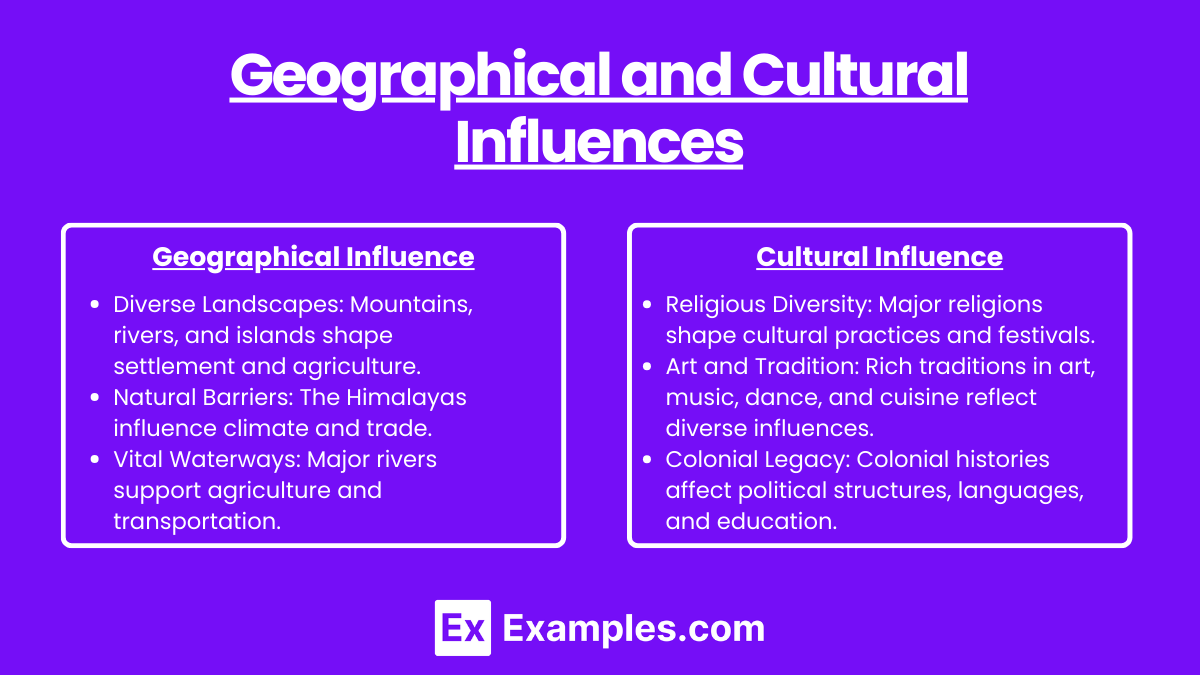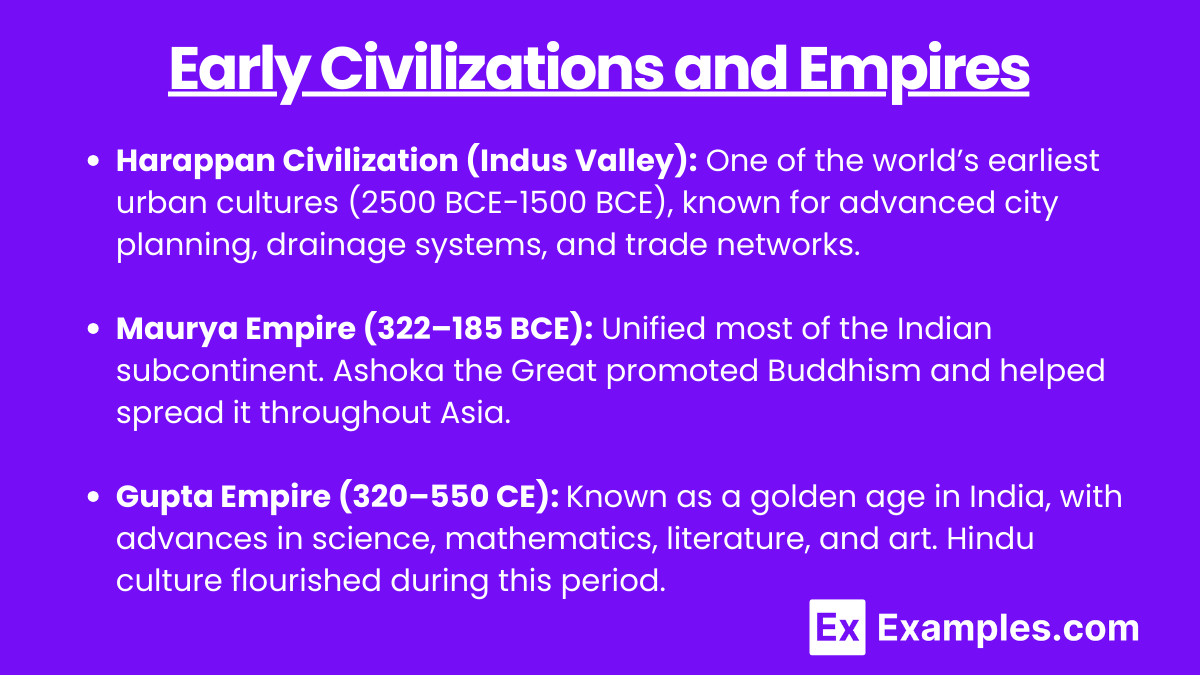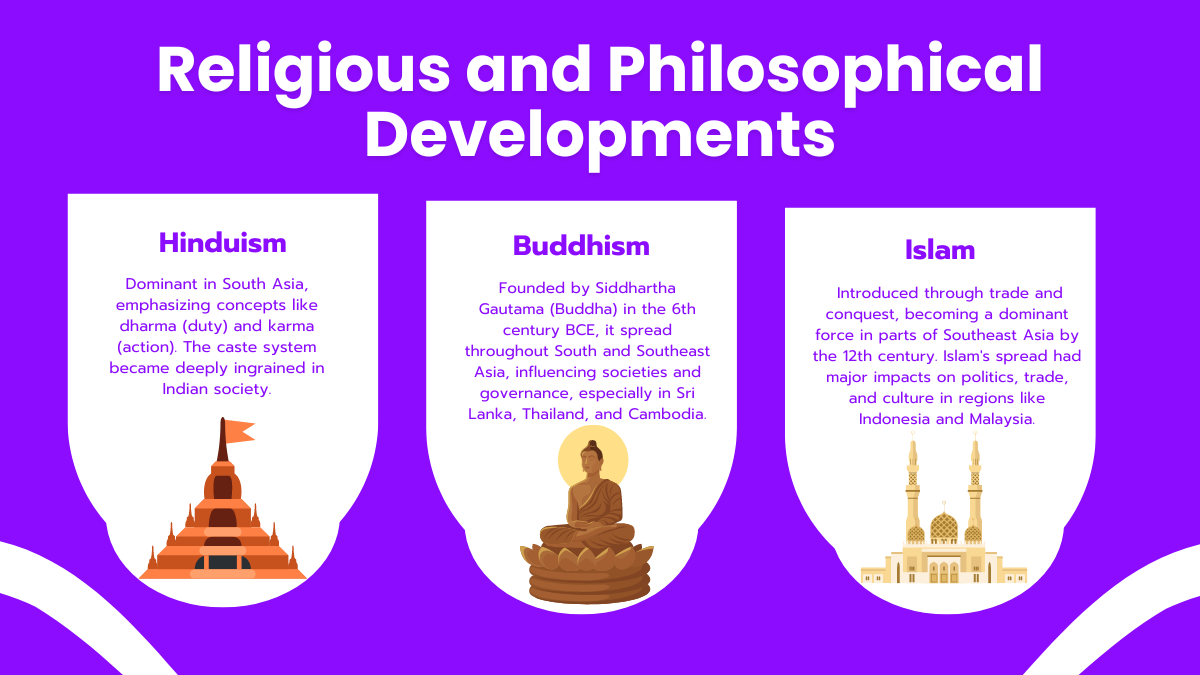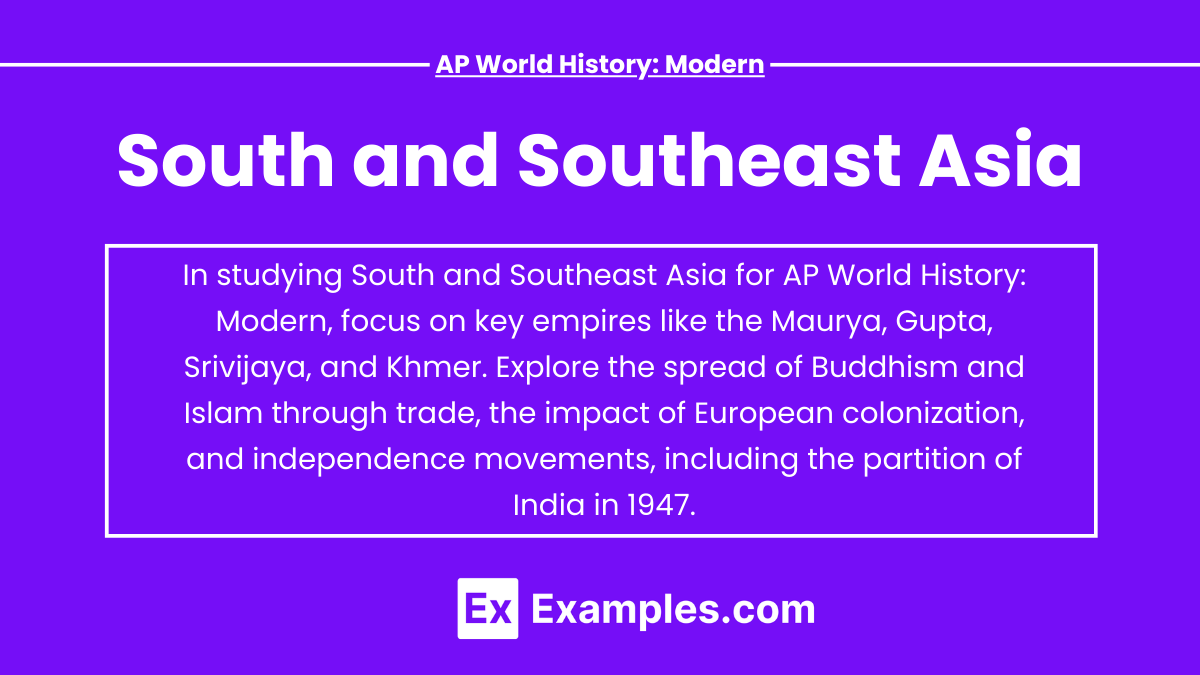South and Southeast Asia have played pivotal roles in world history due to their rich cultural, religious, and economic contributions. This region saw the rise of influential empires like the Maurya, Gupta, Srivijaya, and Khmer, which shaped political and religious developments. Major trade routes, particularly the Indian Ocean Trade Network, facilitated the spread of goods and ideas, including Buddhism and Islam. The area also experienced significant colonial influence, leading to eventual independence movements and lasting geopolitical shifts, such as the partition of India in 1947.
Learning Objectives
When studying “South and Southeast Asia” for AP World History: Modern, focus on understanding the influence of major empires like the Maurya, Gupta, Srivijaya, and Khmer empires in shaping the region’s political, cultural, and economic landscape. Examine the spread of Buddhism and Islam throughout these areas, particularly through trade routes like the Indian Ocean Trade Network, and how these religions influenced local societies. Additionally, assess the impact of European colonization by powers such as the British and Dutch, as well as the nationalist movements that led to independence. Lastly, study the partition of India in 1947 and its long-term effects on the region.
1. Geographical and Cultural Influences

Geographical Influences in South and Southeast Asia
- Diverse Landscapes: Includes mountains (Himalayas), rivers (Ganges, Mekong), plains, and islands influencing settlement and agriculture.
- Natural Barriers: The Himalayas provide protection and affect climate, impacting trade routes and cultural exchange.
- Vital Waterways: Major rivers are essential for agriculture, irrigation, and transportation, supporting local economies.
- Monsoon Climate: Seasonal rains dictate agricultural practices, with rice being a staple crop in many areas.
- Coastal Trade: Coastal regions facilitate trade and cultural exchange with neighboring countries, enhancing economic growth.
Cultural Influences in South and Southeast Asia
- Religious Diversity: Major religions like Hinduism, Buddhism, Islam, and Sikhism shape cultural practices and festivals.
- Art and Tradition: Rich traditions in art, music, dance, and cuisine reflect a blend of indigenous and external influences.
- Colonial Legacy: Colonial histories have influenced political structures, languages, and education systems in the region.
- Cultural Exchange: Trade routes, such as the Silk Roads, fostered the sharing of ideas, technologies, and artistic expressions.
- Social Norms: Cultural practices and societal values are deeply rooted in historical and religious contexts, affecting daily life.
2. Early Civilizations and Empires

- Harappan Civilization (Indus Valley): One of the world’s earliest urban cultures (2500 BCE-1500 BCE), known for advanced city planning, drainage systems, and trade networks.
- Maurya Empire (322–185 BCE): Unified most of the Indian subcontinent. Ashoka the Great promoted Buddhism and helped spread it throughout Asia.
- Gupta Empire (320–550 CE): Known as a golden age in India, with advances in science, mathematics, literature, and art. Hindu culture flourished during this period.
3. Religious and Philosophical Developments

- Hinduism: Dominant in South Asia, emphasizing concepts like dharma (duty) and karma (action). The caste system became deeply ingrained in Indian society.
- Buddhism: Founded by Siddhartha Gautama (Buddha) in the 6th century BCE, it spread throughout South and Southeast Asia, influencing societies and governance, especially in Sri Lanka, Thailand, and Cambodia.
- Islam: Introduced through trade and conquest, becoming a dominant force in parts of Southeast Asia by the 12th century. Islam’s spread had major impacts on politics, trade, and culture in regions like Indonesia and Malaysia.
Examples
Example 1 : The Maurya and Gupta Empires
The Maurya Empire (322–185 BCE) unified most of the Indian subcontinent, with Ashoka the Great promoting Buddhism across Asia. The Gupta Empire (320–550 CE) marked a golden age in India, characterized by advancements in mathematics, science, literature, and art, and the flourishing of Hindu culture. These empires laid the foundation for Indian civilization and had long-lasting influences on South Asia’s political and cultural landscapes.
Example 2 : The Spread of Buddhism
Buddhism originated in South Asia (India) in the 6th century BCE and spread across Southeast Asia through trade and missionary work. Major kingdoms like the Khmer Empire in Cambodia adopted Buddhism alongside Hinduism, as seen in the iconic Angkor Wat temple complex. Similarly, Sri Lanka and Southeast Asian countries such as Thailand and Myanmar became major centers for Theravada Buddhism, shaping religious practices and cultural traditions.
Example 3 : Indian Ocean Trade Network
South and Southeast Asia were vital participants in the Indian Ocean trade network, facilitating the exchange of goods, culture, and ideas between regions as far as East Africa, the Middle East, and China. Kingdoms like Srivijaya and Majapahit in Southeast Asia thrived by controlling trade routes, particularly for spices, textiles, and luxury goods, making the region a crucial part of global commerce during this era.
Example 4 : European Colonization
South and Southeast Asia were heavily influenced by European colonial powers in the 16th to 20th centuries. India was controlled by the British, while the Dutch established dominance over Indonesia, and the French colonized Indochina (Vietnam, Cambodia, Laos). These colonial regimes exploited the region’s resources, introduced Western systems of governance, and led to widespread resistance movements that culminated in independence for many countries post-World War II.
Example 5 : Partition of India and its Aftermath
In 1947, the British partitioned India into two nations: Hindu-majority India and Muslim-majority Pakistan. This event led to one of the largest mass migrations in history and significant violence between religious communities. The partition had lasting impacts on regional politics, including ongoing tensions between India and Pakistan, particularly over the Kashmir region. It reshaped the geopolitical landscape of South Asia in the post-colonial era.
Multiple Choice Questions
Question 1
Which empire was known for its promotion of Buddhism and unification of most of the Indian subcontinent?
A) Gupta Empire
B) Maurya Empire
C) Srivijaya Empire
D) Khmer Empire
Answer: B) Maurya Empire
Explanation: The Maurya Empire, particularly under Emperor Ashoka, promoted Buddhism throughout Asia and unified much of the Indian subcontinent. Ashoka’s embrace of Buddhism after the Kalinga War played a crucial role in its spread to regions like Sri Lanka and Southeast Asia.
Question 2
What was a significant outcome of the Indian Ocean Trade Network in South and Southeast Asia?
A) The development of feudalism
B) The spread of Islam and Buddhism
C) The unification of Southeast Asia under a single ruler
D) The decline of local economies in South Asia
Answer: B) The spread of Islam and Buddhism
Explanation: The Indian Ocean Trade Network facilitated cultural and religious exchanges, leading to the spread of Islam and Buddhism in regions like Southeast Asia. Trade routes allowed merchants and missionaries to introduce new ideas and religions to places like Indonesia and Cambodia.
Question 3
What was one of the primary causes of the partition of India in 1947?
A) Conflict between Hindu and Muslim populations
B) Influence of British economic policies
C) Failure of India’s independence movement
D) Rise of the Gupta Empire
Answer: A) Conflict between Hindu and Muslim populations
Explanation: The partition of India was largely driven by religious conflict between Hindu and Muslim populations. The division of British India into the predominantly Hindu India and Muslim-majority Pakistan led to mass migrations and violence, reshaping the geopolitical landscape of South Asia.


